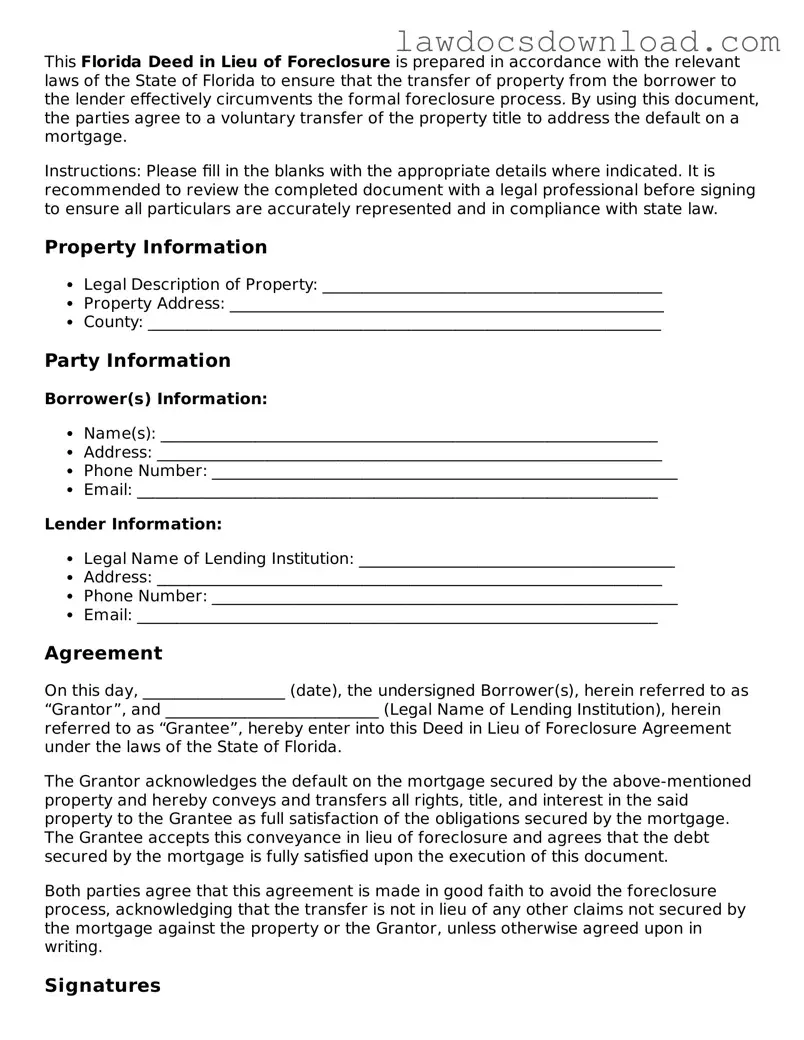The Florida Deed in Lieu of Foreclosure form shares similarities with various other legal documents, each serving distinct yet occasionally overlapping purposes. Understanding these documents enhances comprehension of the nuanced landscape of real estate and financial agreements.
One such document is the Mortgage Agreement. Similar to the Deed in Lieu of Foreclosure, a Mortgage Agreement establishes a legal relationship between a lender and a borrower, using real property as collateral to secure a loan. Both documents are pivotal in real estate transactions but serve different stages; while a mortgage initiates the borrowing process, a deed in lieu may conclude it, often when the borrower is unable to fulfill repayment obligations.
The Quitclaim Deed, likewise, has parallels with the Deed in Lieu of Foreclosure. Both convey property ownership without the seller making guarantees about the property title's status. However, their usage diverges significantly; a Quitclaim Deed is often used between family members or to clear title issues, whereas a Deed in Lieu transfers property back to the lender to avoid foreclosure.
Another related document is the Warranty Deed, which, unlike the Deed in Lieu, provides the buyer with guarantees about the property’s title status and ownership. Although their purposes differ—with the Warranty Deed primarily used in straightforward sales—the act of transferring property rights links them closely.
The Forbearance Agreement also shares a connection with the Deed in Lieu of Foreclosure by addressing distressed mortgages. It allows the borrower a temporary reduction or suspension of payments, aiming to prevent foreclosure. Both documents are tools in the lender’s and borrower’s arsenals for managing financial hardship, albeit at different stages of distress.
A Loan Modification Agreement is another document with similarities. This agreement changes the terms of the original mortgage to make repayment more feasible for the borrower. Like a Deed in Lieu, it's a recourse for borrowers facing financial difficulties, aiming to avoid foreclosure, but it attempts to maintain the repayment schedule rather than transferring property ownership.
The Short Sale Agreement, used when a property is sold for less than the amount due on the mortgage with the lender's approval, also aligns with the Deed in Lieu’s purpose of avoiding a full-blown foreclosure. Both options provide a way out for borrowers unable to meet their mortgage obligations, but the processes and outcomes differ.
Similarly, the Promissory Note is foundational to mortgage agreements, setting forth the borrower's promise to pay back the loan. It's the genesis of the relationship that may eventually lead to considering a Deed in Lieu of Foreclosure if the borrower defaults, underscoring the interconnectedness of these financial documents.
The Release of Lien is another related document, signaling the conclusion of a financial obligation tied to property. Like a Deed in Lieu, it marks the resolution of a conflict over property rights, albeit from a different angle—releasing the borrower from further obligations under the original terms once a debt is settled.
Lastly, the Trust Deed serves a parallel purpose to the mortgage but involves a third-party trustee holding the property title until the loan is repaid. In instances where repayment becomes untenable, a Deed in Lieu might be considered as an alternative solution, echoing the complexity and interrelation of these legal instruments in managing real estate financing.
Understanding these documents and their relationships to the Deed in Lieu of Foreclosure form illuminates the broader context of real estate transactions and financial distress solutions. Each serves a unique purpose in the intricate dance between lending, borrowing, and owning real estate, demonstrating the multifaceted approaches to resolving financial challenges.
